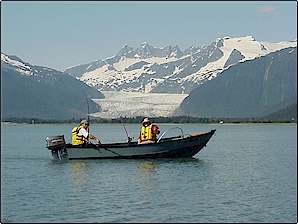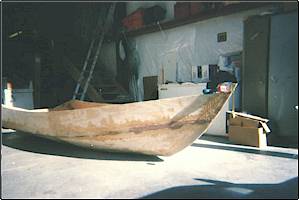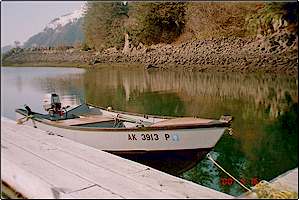The
Unintentional Custom Boat
By Ed Sasser BoldEagle@boatbuilding.com
Those aren't blunders; those are features
the designer didn't intend. |
If asked, I could say that the sheer on my Diablo is two inches lower
at the bow than the plans specify so as to accommodate local conditions here in Juneau,
Alaska. I customized it so when I'm trolling with the Taku winds abeam they won't blow me
off course. I could say that but the truth is I screwed up the stem angle on the side
panels and faced the classic boat builder's dilemma: How does one proceed from the point
of discovering a major mistake?
In the Beginning
 Having lofted and built three other boats either in teams or with partners, I
believed I was ready to float solo. The question was: what plan should I start with? I
live on a Nordic tug moored in Juneau's Douglas Harbor. A narrow cut that is wetted at a
plus 10 tide separates the mainland from Douglas Island. When I want to access the waters
north of the island, tides and logistics become primary concerns. A light skiff that could
get me to the north end of the Island quickly, either by trailer or over the bar, seemed a
logical choice. Having lofted and built three other boats either in teams or with partners, I
believed I was ready to float solo. The question was: what plan should I start with? I
live on a Nordic tug moored in Juneau's Douglas Harbor. A narrow cut that is wetted at a
plus 10 tide separates the mainland from Douglas Island. When I want to access the waters
north of the island, tides and logistics become primary concerns. A light skiff that could
get me to the north end of the Island quickly, either by trailer or over the bar, seemed a
logical choice.
I chose to build just to see if I could. In fact, cost was never a
consideration for me. Wages are comparatively high here in Alaska and when friends drop in
to look at my various projects they sometimes ask: "How much will you save by
building your own boat?" My answer is always: "Not a cent". Considering the
alternative forgone at my prevailing wage, the answer is true. It's just that, if given a
choice of how to spend my time, I'd rather build this boat for $2.50 an hour than make ten
times that at my regular job.
An important question to ask yourself before you start any boat building project is:
"Do I want to have built a boat or do I want to be building a
boat." If you genuinely enjoy the process, not just the product, go ahead and order
the plans.
I zeroed in on Diablo since it met my specs and had the reputation of being a proven
"New Instant Boat". Besides, I thought that by working with epoxy I could blame
my behavior on the fumes. I took all the advice--well most of the advice--Harold Payson
and Phil Bolger had to give regarding the building of Diablo, a 15- foot, flat-bottomed,
plywood skiff with taped-seam chines. The Diablo was a good first solo project for me.
When the plans arrived, I plopped down in my "wailing chair" and poured over the
sheets. I didn't pick up a saw 'til I was dreaming about the penciled plywood awaiting
butt-scarfing on my shop floor. This is where some experience with lofting pays off. While
lofting isn't required for Diablo, using brads on the station points and trusting one's
eye and fair batten rather than the measured marks is useful. Finally, I cut everything to
within a 32nd of an inch and started the assembly process.
|
 The
taped bottom looks like a Diablo. It went together with greater
difficulty and required wire to hold the pieces in place for taping.
The piece on top was cut off the bilge panel to get it to fit. The
taped bottom looks like a Diablo. It went together with greater
difficulty and required wire to hold the pieces in place for taping.
The piece on top was cut off the bilge panel to get it to fit. |
Let there be Light
Why was the bow sheer so long on top? Why didn't it match up
with the stem? Maybe if I trim a little here. That should do
it.
The sidebar to this piece indicates in lurid
detail what I did wrong on the plan. Once the fateful cut was made I saw three
options (no pun intended): 1) Trim the side panel to fit-- which of course will affect the
bilge panels, frame locations and everything else; 2) Pull the side panels off the transom
and re-cut them from two new sheets or 3) Cut the bow end off the side panels--say two
feet or so--and re-scarf the correct angle onto the side panels. Insert your own (fourth)
option here since everyone is in the advice business these days. Knowing whose advise to
take and whose to ignore is one of the secrets to existence.
Operating on the principle that I shouldn't look back because something might be
gaining on me, (Sachel Paige) I barged ahead with option one--inventing an entirely new
boat in the process. I saved nearly three hours by not having to knock the brads out of
the transom and re-cut the side panels. What I added was three days of head scratching,
staring at plywood and tracing bilge panels much the same as Payson probably does when
building the Bolger prototypes. So much for "within a 32nd of an inch".
|
 The upright hull
indicates where the stem should be if this were a correctly-cut Diablo. The tape measure
indicates what will need to cut off the stem to match the sheer. The upright hull
indicates where the stem should be if this were a correctly-cut Diablo. The tape measure
indicates what will need to cut off the stem to match the sheer. |
A new dementiaThe new dimensions of the boat
stretched the limits of the ACX plywood I was using and I had to wire the panels together
in several places. I also had to use a little more filler than I had planned. This gave me
a good opportunity to try the various items that came in my System Three® sample pack as
well as some of my own ideas and creations. Some of the creations were more successful
than others but I viewed all of this boat as an experiment and a learning process and,
thus, all of the expenses as tuition.
I liked making my own wood flour by double sifting my shop floor sweepings. For some
epoxy-thickening applications Fix-All® worked pretty well. Made of wood flour, gypsum,
starch and lime, it never set up quite right for vertical surfaces--it sagged-- but worked
very well on the horizontal seams. Rather than turning to a "peanut butter"
consistency it would kick into a gum like Liquid Nails® floor joist adhesive. I also
ended up using Bondo® especially where I had had wire holes and wanted a smooth surface
prior to exterior taping. In fact, about the only two powders in my shop I didn't try
using as fillers were the Metimusal® and the Jello® pudding and pie filling. The
Metimusal® might actually have pretty good sanding characteristics. I’ve since gone
out and purchased a 50-pound bag of silica. Never want to run out of thixotropic agents
again.
I used WEST System Brand® epoxy and hardener throughout since it was the only brand
locally available. I’d love if there were more local retail competition in the epoxy
market here but that is currently not the case. The safest course of action in a first
project is to stick with the four or five established thickeners and use them for the
prescribed applications. If you mix your own concoctions, just remember to test them on
scrap before using them on the boat.
|
 The finished project is
a custom boat with features the designer didn't intend. With a 25-horse Johnson and a
graphite bottom, the Diablo easily hits 30 PMH. The finished project is
a custom boat with features the designer didn't intend. With a 25-horse Johnson and a
graphite bottom, the Diablo easily hits 30 PMH. |
The Wages of Original SinThe re-cutting and the
extra filling resulted in some analysis of my choice to proceed with option one. A review
of my sanity seemed to be in order as well. The experience was a classic case of "It
seemed like a good idea at the time" and it is important not to beat yourself up too
much at those moments. I tried to think of what my friend Bill the philosophy major would
say but all I can remember is the three enduring questions he asks daily: 1) Why am I
here? 2) Is there a God? and 3) Do you want fries with that? Further examination and
discussion with the local boatbuilding support group reminded me that attitude makes the
difference.
All's well that….Oh Well!
I'm not obsessive-compulsive. (I found I didn't have time to collect all the web sites
having to do with obsessive-compulsive disorder on the inter-net). But as I write this I'm
waiting for the delivery of the plywood for laying out a new Diablo--a real one this time.
The only question is do I owe "Dynamite" another plan fee--seeing as how the
first boat isn't actually a Diablo.

|
 |
Ed Sasser works six months a year as the Deputy Compact Administrator for
Alaska's Interstate Compact for the Placement of Children. The rest of the time he
"messes about in boats". |
| The Unkindest Cut of All  I measured everything
several times prior to cutting. I even used two different devices in case one was faulty.
First I used my tape measure--the one my wife calls my "Norwegian pager". Then I
checked my work with my metal rule. In this case I was measuring back from the station
line but from the wrong point on that line (see graphic). I was measuring from the bottom
of the side panel rather than from the bottom of the plywood. As a result the angle was
too steep. This steep angle had to be trimmed on top to match the stem (under my option
one). The rest is history. I measured everything
several times prior to cutting. I even used two different devices in case one was faulty.
First I used my tape measure--the one my wife calls my "Norwegian pager". Then I
checked my work with my metal rule. In this case I was measuring back from the station
line but from the wrong point on that line (see graphic). I was measuring from the bottom
of the side panel rather than from the bottom of the plywood. As a result the angle was
too steep. This steep angle had to be trimmed on top to match the stem (under my option
one). The rest is history.
One of the measures of builders is how they respond to stupid mistakes. Sometimes we
manage to do something even more stupid to attempt to correct the first one. Many of us
are more forgiving of others than we are of ourselves. Next to sheer persistence, I rate
forgiveness as a necessary component in completion of a boat-building project. In fact,
after talking with my boat builder support group, skill seems to come in between fifth and
tenth place in the priority order of characteristics likely to result in a floating
project. Many articles review the skills required to build a boat. Fewer deal with the
character traits required.
Measuring correctly in both instances is necessary for project completion.
ES
This article originally appeared in the November/December 2000 issue of Boatbuilder.
www.boatbuildermagazine.com
|

|
![]()